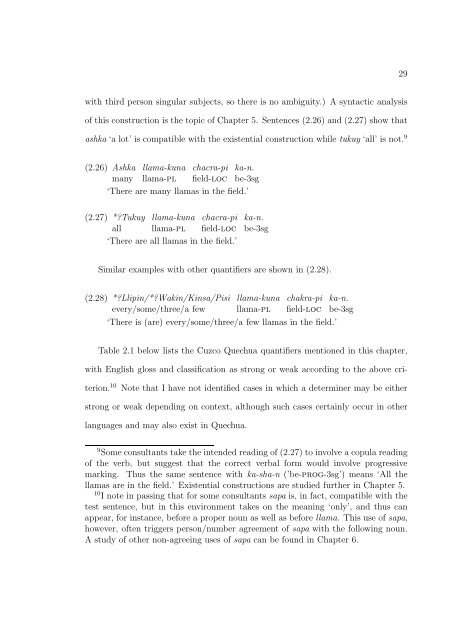the syntax and semantics of relativization and quantification
the syntax and semantics of relativization and quantification
the syntax and semantics of relativization and quantification
You also want an ePaper? Increase the reach of your titles
YUMPU automatically turns print PDFs into web optimized ePapers that Google loves.
29<br />
with third person singular subjects, so <strong>the</strong>re is no ambiguity.) A syntactic analysis<br />
<strong>of</strong> this construction is <strong>the</strong> topic <strong>of</strong> Chapter 5. Sentences (2.26) <strong>and</strong> (2.27) show that<br />
ashka ‘a lot’ is compatible with <strong>the</strong> existential construction while tukuy ‘all’ is not. 9<br />
(2.26) Ashka<br />
many<br />
llama-kuna<br />
llama-pl<br />
chacra-pi<br />
field-loc<br />
ka-n.<br />
be-3sg<br />
‘There are many llamas in <strong>the</strong> field.’<br />
(2.27) *?Tukuy<br />
all<br />
llama-kuna<br />
llama-pl<br />
chacra-pi<br />
field-loc<br />
‘There are all llamas in <strong>the</strong> field.’<br />
ka-n.<br />
be-3sg<br />
Similar examples with o<strong>the</strong>r quantifiers are shown in (2.28).<br />
(2.28) *?Llipin/*?Wakin/Kinsa/Pisi<br />
every/some/three/a few<br />
llama-kuna<br />
llama-pl<br />
chakra-pi<br />
field-loc<br />
‘There is (are) every/some/three/a few llamas in <strong>the</strong> field.’<br />
ka-n.<br />
be-3sg<br />
Table 2.1 below lists <strong>the</strong> Cuzco Quechua quantifiers mentioned in this chapter,<br />
with English gloss <strong>and</strong> classification as strong or weak according to <strong>the</strong> above criterion.<br />
10 Note that I have not identified cases in which a determiner may be ei<strong>the</strong>r<br />
strong or weak depending on context, although such cases certainly occur in o<strong>the</strong>r<br />
languages <strong>and</strong> may also exist in Quechua.<br />
9 Some consultants take <strong>the</strong> intended reading <strong>of</strong> (2.27) to involve a copula reading<br />
<strong>of</strong> <strong>the</strong> verb, but suggest that <strong>the</strong> correct verbal form would involve progressive<br />
marking. Thus <strong>the</strong> same sentence with ka-sha-n (’be-prog-3sg’) means ‘All <strong>the</strong><br />
llamas are in <strong>the</strong> field.’ Existential constructions are studied fur<strong>the</strong>r in Chapter 5.<br />
10 I note in passing that for some consultants sapa is, in fact, compatible with <strong>the</strong><br />
test sentence, but in this environment takes on <strong>the</strong> meaning ‘only’, <strong>and</strong> thus can<br />
appear, for instance, before a proper noun as well as before llama. This use <strong>of</strong> sapa,<br />
however, <strong>of</strong>ten triggers person/number agreement <strong>of</strong> sapa with <strong>the</strong> following noun.<br />
A study <strong>of</strong> o<strong>the</strong>r non-agreeing uses <strong>of</strong> sapa can be found in Chapter 6.
















